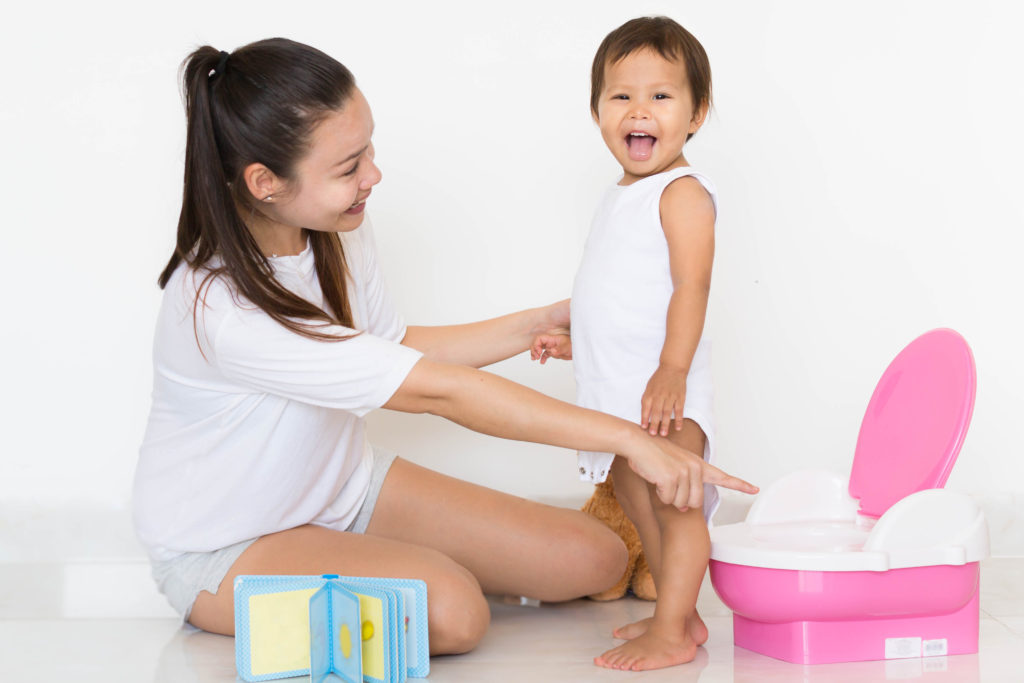TIPS FOR SUCCESSFUL POTTY TRAINING

It might be the most challenging thing to do with your little one but with a bit of extra time at home these days, potty training can be easier than ever! Here are some tips for success in the bathroom.
First, get prepared.
- Start teaching your child the appropriate vocabulary when they are about 18 months old. Be sure they know that it’s normal for everyone (even animals!) to go pee and poo.
- Around the same time, start to offer your child a pull-up diaper instead of a regular diaper. This helps them prepare for the next step, underwear.
- Look for signs of potty readiness. They may tell you they have already gone pee or poop, they may complain or pull at a dirty diaper, or they may run to a corner to go to the bathroom.
- Let your child pick out underwear with their favorite character to be used when they are ready.
- Set up your bathroom for potty training: buy a floor-level type potty chair or sturdy slip-proof steps to let them reach the regular toilet that’s been outfitted with an adapted smaller seat. Again, take your child along when you buy the potty chair or steps – this helps your child learn that learning to use the toilet is important and a sign of growing up.
The potty training process – options for success:
- Have your child observe toilet-trained children (or you as a parent) use the toilet. If you have an older child who can show their younger sibling what to do, that’s also helpful.
- Help your child get used to the potty chair by having them sit on it for short amounts of time fully clothed or in a diaper until they are comfortable with it. Don’t start actual toilet training until your child has clearly has good feelings about the potty chair. Then, bring the potty chair in the bathroom and have your child sit on it (bare-bottom) when you sit on the toilet.
- Encourage “practice runs” to the potty – ask your child to walk to the potty and sit down with their diapers or pull ups off. Try this technique after naps, during any two hour period without a wet diaper or pull up, or 20 minutes after a meal. Don’t ask your child if they need to go – remove the option for a decision and state to your child, “The poop or pee wants to come out. Let’s use the potty.”
- Plan a “bare bottom” weekend. If your child is older than 30 months and has successfully used the potty a few times with your help and clearly understands the process, commit an entire day or a weekend exclusively to toilet training. Avoid interruptions or distractions during this time (turn off the tv and avoid using your phone). You’ve got to have an eye on your child to see the signs that they need to use the bathroom.
- If your child successfully uses the toilet, reward them with treats like small treats and stickers – don’t forget the verbal praise and hugs! Although a sense of accomplishment is enough for some children, many need treats to stay focused. Big rewards (such as going to the toy store) should be reserved for when your child is fully potty trained.
Remember:
- Don’t force your child to sit on the potty and don’t physically hold your child in place. Even if your child seems to be enjoying it, end each training session after 5 minutes (unless something is happening).If your child is resistant, it’s time to stop the potty training and come back to it when they are ready.
- Praise or reward your child for cooperation or any success. All cooperation with these practice sessions should be praised.
- Make sure you are giving plenty of fruits and veggies and water to keep your child’s stool from being too hard. Remember it might take a couple of years for your child to stay dry through the night.
- If your child has an accident, change their clothes and respond sympathetically. Don’t yell or punish your child for the accident. Pressure or force can make a child uncooperative.
Remember, your CPCMG pediatrician is here to help you with anything – no question is off limits! Many of us are parents, too and have been through exactly what you’re experiencing.

